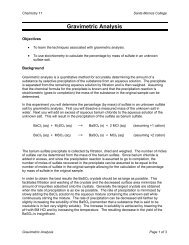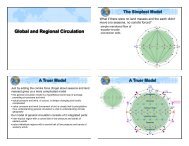Anaplasia/Dysplasia handout - read
Anaplasia/Dysplasia handout - read
Anaplasia/Dysplasia handout - read
Create successful ePaper yourself
Turn your PDF publications into a flip-book with our unique Google optimized e-Paper software.
Section 1 Cancer Terminology<br />
OBJECTIVES:<br />
Upon completing this section, you should be able to:<br />
1. Define the following terms: cancer, tumor, anaplasia, hyperplasia,<br />
dysplasia, differentiation, metastasis, and micrometastases.<br />
2. Explain the difference between a benign and malignant tumor.<br />
3. Briefly describe the stem cell theory of cell growth and differentiation.<br />
10
Section 1 Cancer Terminology<br />
The study of cancer will begin by defining several<br />
terms necessary to the understanding of the topic.<br />
CANCER<br />
Surprisingly, there are many definitions of the<br />
word cancer, but none is universally accepted. Any<br />
definition must embody two characteristics: the<br />
property of uncontrollable growth of cells originating<br />
from normal tissue, and the property of killing<br />
the host by means of local tissue invasion and/or<br />
distant sp<strong>read</strong> (metastasis). Some have defined<br />
cancer as autonomous growth that is unresponsive<br />
to normal growth-regulatory factors. Others have<br />
emphasized the irreversibility with which cancer<br />
cells lose the differentiated characteristics and<br />
physiologic functions of the mature tissue of origin.<br />
Still others have emphasized the gross or<br />
microscopic anatomy of tumors, or the growth and<br />
antigenic properties that they share with fetal cells.<br />
A good working definition is that cancer is a<br />
group of diseases characterized by uncontrolled<br />
cellular growth with local tissue invasion and/or<br />
systemic metastasis. In the subsequent pages, we<br />
will take a closer look at the properties of cancer<br />
cells.<br />
ANAPLASIA,DYSPLASIA, AND<br />
HYPERPLASIA<br />
<strong>Anaplasia</strong>, dysplasia, and hyperplasia are three<br />
words commonly used in reference to malignancies.<br />
The suffix plasia means “formation.” The<br />
prefixes “ana,” “dys,” and “hyper” give these<br />
words their unique meanings.<br />
<strong>Anaplasia</strong> is the loss of structural organization<br />
and useful function of a cell. Generally, cancer<br />
cells resemble undifferentiated or primitive cells<br />
that have not developed the specialized cell structure<br />
typical of their tissue of origin. In other words,<br />
instead of developing into nerve cells or muscle<br />
cells, they remain in an undifferentiated, primitive<br />
state. The degree of anaplasia varies; sometimes<br />
the tumors are so undifferentiated, it is literally<br />
impossible to determine the tissue of origin.<br />
<strong>Dysplasia</strong> is a disturbance in the size, shape, and<br />
organization of cells and tissues. <strong>Dysplasia</strong> is<br />
abnormal—but not yet cancerous—tissue development.<br />
The epidermis and mucosal surfaces (linings<br />
of the mouth, nose, intestine, cervix) that normally<br />
and constantly undergo cellular multiplication, differentiation,<br />
organization, and death are common<br />
sites of dysplasia. <strong>Dysplasia</strong> also is common in<br />
chronic inflammatory and proliferative lesions,<br />
and it is recognized as part of a developmental<br />
phase of many neoplasms.<br />
Hyperplasia is an increase in the number of cells<br />
in a tissue or organ causing an increase in the<br />
bulk of an organ. It should not be confused with<br />
hypertrophy, which is an increase in the size of<br />
the constituent cell. Nor is hyperplasia a synonym<br />
for tumor growth. Hyperplasia is induced by<br />
known stimuli and is a controlled process; inasmuch<br />
as it stops when the stimulus has ceased. In<br />
addition, hyperplasia may serve a useful purpose,<br />
such as preparing breast tissue for lactation or<br />
reconstituting the liver with structurally normal<br />
cells after partial hepatectomy. Tumor growth<br />
obeys none of these rules or purposes. However,<br />
cancerous changes may eventually occur in<br />
hyperplastic tissue.<br />
Because hyperplasia and dysplasia often precede<br />
the development of many tumors by months or<br />
even years, recognition and proper treatment at this<br />
early stage in the development process may help to<br />
prevent malignancies. For example, the<br />
Papanicolaou Smear (or Pap Smear) permits differentiation<br />
among normal, dysplastic, or cancerous<br />
cells, a technique that allows early detection of<br />
cervical cancer. The Pap Smear has greatly<br />
reduced the morbidity and mortality of cervical<br />
cancer.<br />
DEFINING,NAMING, AND<br />
CLASSIFYING TUMORS<br />
The word tumor is derived from the Latin word<br />
tumere, meaning “to swell.” At one time, the word<br />
was used to indicate any type of swelling (traumatic,<br />
inflammatory, neoplastic). Today, its meaning<br />
often is used synonymously with the term<br />
“neoplasm.” Composed of two terms, neo (new)<br />
and plasma (formation), the word neoplasm refers<br />
11
to an abnormal growth of tissue whose cells usually<br />
have rapid growth. Neoplasia is the pathologic<br />
process that results in the formation and growth of<br />
a neoplasm (tumor). A tumor can be either benign<br />
or malignant.<br />
Benign Tumors<br />
The word benign means nonmalignant and suggests<br />
that such tumors are harmless. In many<br />
cases, this is true. But a benign tumor can lead to<br />
death if it grows in a critical area of the body, such<br />
as the brain. Also, over a period of time, some<br />
benign tumors do become malignant.<br />
Let’s review distinguishing features of benign<br />
tumors.<br />
First, a benign tumor usually is encapsulated by a<br />
well-defined fibrous cover (like the skin of an<br />
orange) separating the mass from surrounding<br />
tissue.<br />
Second, a benign tumor neither invades surrounding<br />
tissue nor metastasizes (sp<strong>read</strong>s via the blood<br />
and lymphatic systems), but remains within the<br />
site of origin.<br />
Third, benign tumor cells exhibit a lesser degree of<br />
anaplasia (loss of structural organization and useful<br />
function) than do cells of a malignant tumor.<br />
Therefore, benign tumor cells resemble normal<br />
cells; they are said to be typical of the cells or tissues<br />
of origin.<br />
Fourth, benign tumors usually grow slowly. (This<br />
is a generalization; some malignant tumors, such<br />
as breast cancers, also grow slowly, while some<br />
benign tumors, such as leiomyomas, grow rapidly.)<br />
Fifth, benign tumors do not progress in a uniform<br />
manner. Their growth may be slow, stationary, or<br />
they may even regress.<br />
Finally, recurrence is rare after simple surgical<br />
removal.<br />
Thus benign tumors generally are less dangerous<br />
to the patient than malignant tumors.<br />
Most benign tumors are named by adding the suffix<br />
oma to the cell composing the tumor. For<br />
example, a benign tumor composed of fibrocytes<br />
(connective tissue cells) is called a fibroma; one<br />
composed of lipid (fat) cells, is called a lipoma. All<br />
benign tumors arising from muscle or connective<br />
tissue cells, such as bones, cartilage, and tendons,<br />
are named this way.<br />
Benign epithelial tumors also are named by adding<br />
the suffix oma to a base word, but, in this case,<br />
some are named according to cells of origin, while<br />
others are named according to their microscopic or<br />
macroscopic appearance.<br />
An example of a name based on the cell of origin is<br />
adenoma. The prefix adeno is from the Greek word<br />
adenos, meaning “gland.” Benign epithelial tumors<br />
that either arise from cells that form glandular patterns<br />
or develop from glands, but do not necessarily<br />
form glandular patterns, are called adenomas.<br />
Other benign epithelial tumors sometimes are<br />
named according to microscopic or macroscopic<br />
appearance. Macroscopically, for instance, an<br />
epithelial tumor forming a large cystic mass, such<br />
as found in the ovary, is referred to as a cystoma,<br />
or a cystadenoma. One having microscopic or<br />
macroscopic finger-like projections is called a<br />
papilloma (papilla = nipple-shaped projection).<br />
Malignant Tumors<br />
The word malignant means to have the property of<br />
local invasion and destructive growth and metastasis,<br />
and is derived from a Latin term meaning<br />
“wicked.” The distinguishing features of malignant<br />
tumors make it clear why this type of tumor was so<br />
named.<br />
First, malignant tumors usually infiltrate or invade<br />
surrounding tissue. This peculiar characteristic<br />
may be why the term cancer (meaning “crab”) was<br />
chosen, because certain types of breast cancer<br />
resemble a crab with claw-like processes extending<br />
deep into breast tissue. Cancers almost never<br />
are encapsulated. Although an occasional, slowly<br />
expanding malignant tumor may appear to develop<br />
an enclosing fibrous membrane, histologic examination<br />
may reveal tiny crab-like penetrations<br />
through such encapsulation.<br />
12
Second, malignant tumors frequently metastasize,<br />
which refers to the sp<strong>read</strong> of primary tumor cells<br />
to distant body sites, generally via the lymphatic<br />
system and bloodstream. Table 2 summarizes<br />
some common sites of metastasis from specific<br />
primary tumors.<br />
Third, malignant tumor cells usually are atypical<br />
of the cells of their tissue of origin and have a<br />
greater degree of anaplasia than those of a benign<br />
tumor. Because some similarities usually remain,<br />
the cell of origin can generally be determined.<br />
Fourth, malignant cells exhibit a unique trait called<br />
autonomy. Autonomy is the ability of tumor cells<br />
to grow in an essentially unrestrained manner in<br />
the host. In other words, malignant cells ignore the<br />
normal rule of cell reproduction—they function<br />
outside the limits of growth of normal cells and are<br />
not responsive to normal controls on cell numbers.<br />
Fifth, with malignant tumors, unlike benign<br />
tumors, recurrence is more common after surgical<br />
removal because cells have invaded surrounding<br />
tissue or have metastasized and are not removed or<br />
destroyed by treatment. Such local invasion and<br />
metastasis may be microscopic and not detected at<br />
the time of treatment.<br />
Sixth, cancer cells are genetically unstable and<br />
contain or later develop abnormal numbers of<br />
chromosomes. Since chromosomes contain the<br />
genes that transmit hereditary characteristics, this<br />
instability explains the unusual and constantly<br />
changing characteristics of the cancer cell.<br />
Table 2.<br />
Common Sites of Metastasis From Primary Tumors<br />
Primary Tumor<br />
Head and neck<br />
Colon, pancreas, stomach<br />
Ovary<br />
Breast cancer<br />
Lung cancer<br />
(bronchogenic carcinoma)<br />
Bone, kidney, uterus, testicle<br />
Prostate<br />
Melanoma<br />
Sites of Metastasis<br />
Lymph nodes<br />
Lung<br />
Liver<br />
Lung<br />
Lymph nodes<br />
Intraperitoneal<br />
Lymph nodes<br />
Lung<br />
Bone<br />
Liver<br />
Skin<br />
Chest wall<br />
Brain<br />
Liver<br />
Lymph nodes<br />
Bone<br />
Lung<br />
Bone<br />
Liver<br />
Brain<br />
Lung<br />
13
In summary, a malignant tumor invades surrounding<br />
tissues, usually produces metastases, is likely<br />
to recur after attempted removal, and in most cases<br />
causes death unless adequately treated.<br />
In comparing benign and malignant tumors, a<br />
good example is that of neurofibromatosis, or<br />
von Recklinghausen’s disease (the Elephant Man’s<br />
disease). The characteristic feature of this benign<br />
proliferative disease is the occurrence of “neurofibromas,”<br />
representing benign growth of special<br />
fibroblasts or Schwann cells. These tumors, because<br />
of their association with nerves, may cause a variety<br />
of nerve deficits, including cranial nerve palsies<br />
and spinal cord injury, but they do not invade adjacent<br />
tissue or metastasize. On occasion, however,<br />
they undergo malignant transformation to sarcomas,<br />
which have all the characteristics of malignancy,<br />
including invasion and metastasis. In this<br />
particular example, death may result either from<br />
pressure at a critical point by a benign tumor or<br />
transformation of a benign tumor into a malignant<br />
tumor. Table 3 provides a summary of the differences<br />
between benign and malignant tumors.<br />
Malignant tumors fall into one of two broad classes,<br />
according to tissue of origin. Those malignant<br />
lesions originating from epithelial tissue are called<br />
carcinomas. Those originating from connective<br />
and muscle tissue are called sarcomas. Thus, when<br />
one sees the word carcinoma, it is immediately<br />
clear that the cancer arose from cells of tissue covering<br />
some body surface—the urinary bladder,<br />
uterus, intestinal tract, respiratory tract, etc. Similarly,<br />
sarcomas arise from some type of mesenchymal<br />
(connective) tissues, such as osteogenic sarcoma,<br />
which develops in the long bones.<br />
In many cases, the names of malignant tumors give<br />
a rather precise designation. For example, all carcinomas<br />
originating in the lung parenchyma and<br />
bronchial tubes are called lung cancer or bronchogenic<br />
carcinoma. There are different types of<br />
lung cancer, however, with the name of each type<br />
giving a rather concise description.<br />
Among the various types of bronchogenic carcinoma<br />
are bronchogenic squamous cell carcinomas,<br />
bronchogenic small cell anaplastic carcinomas,<br />
bronchogenic adenocarcinomas, and bronchogenic<br />
Table 3.<br />
Differences Between Benign and Malignant Tumors<br />
Characteristic Benign Tumor Malignant Tumor<br />
Structure and Typical of tissue origin Atypical of tissue origin<br />
differentiation<br />
Rate of growth Usually slow May be slow, rapid, very rapid<br />
Progression Slowly progressive (may remain Usually progressive, almost<br />
stationary; may regress);<br />
always fatal if untreated<br />
rarely fatal if treated<br />
Mode of growth Expansion with capsule Local infiltration and/or<br />
metastasis to distant sites<br />
Tissue destruction None Common, ulceration and necrosis<br />
Recurrence Rare Common<br />
Prognosis Fatal only if surgically Fatal if uncontrolled (untreated)<br />
inaccessible<br />
14
large cell carcinomas. In each case, the name tells<br />
us that all of the above neoplasms occur in the<br />
lungs, with the cell name giving a more precise<br />
histopathologic designation.<br />
Simple, Mixed, and Compound Tumors<br />
Malignant tumors may be classified as being simple,<br />
mixed, or compound.<br />
Simple neoplasms are those with proliferating<br />
(dividing) cells that closely resemble one another.<br />
For example, proliferating cells of squamous cell<br />
carcinoma basically resemble those of stratified<br />
squamous epithelium. Most common cancers fall<br />
into this category.<br />
Mixed and compound tumors are different from<br />
simple tumors. Before explaining them, we need to<br />
know the meaning of germ layers, because these<br />
tumors are composed of cells from the germ layers.<br />
You often will hear oncologists speak of germ<br />
cells in relation to malignancies, such as ovarian<br />
and testicular carcinomas.<br />
The embryo is composed of three layers of tissue<br />
called germ layers. These are basic tissues from<br />
which all other body tissues are formed. The three<br />
germ layers are: 1) the ectoderm, 2) the mesoderm,<br />
and 3) the endoderm.<br />
The ectoderm or outer germ layer is the tissue<br />
from which skin cells, hair follicle cells, sweat<br />
gland cells, and cells of the nervous system are<br />
derived. The mesoderm or middle germ layer gives<br />
rise to muscle cells, bone cells, fascia, and connective<br />
tissue cells. The endoderm or inner germ layer<br />
is the tissue from which the mucosa of the genitourinary<br />
tract, the gastrointestinal tract, and the<br />
respiratory tract are formed.<br />
Mixed neoplasms are tumors composed of more<br />
than one cell type, with the different cells usually<br />
being derived from a single germ layer. An example<br />
is the mixed tumor of the salivary gland originating<br />
in the endoderm. Compound neoplasms are<br />
tumors containing a variety of cell types, with the<br />
cell types originating from more than one germ<br />
layer. An example would be a teratoma, also<br />
referred to as a teratomatous neoplasm, because<br />
well-differentiated tissue found in these tumors<br />
may contain several different types of tissue, such<br />
as bone, teeth, muscle—all rising from the mesoderm—and<br />
hair, skin, or other cells from the ectoderm.<br />
In fact, tissue from any body structure may<br />
be present. It is interesting that the word teratoma<br />
derives from teras, the Greek term for monster.<br />
CELL DIFFERENTIATION AND THE<br />
STEM CELL THEORY<br />
A human life begins as a single cell—a fertilized<br />
egg or ovum. This cell divides into two cells, these<br />
into four, then eight, and so on. There are sequential<br />
triggering mechanisms that cause cells to begin<br />
to specialize, ie, develop new structures and begin<br />
functioning in different ways. Thus, some become<br />
nerve cells, and some become skin cells, and so<br />
on. The process by which normal cells develop<br />
special structures and functions is called differentiation.<br />
The stem cell theory was developed to explain this<br />
complex differentiation process. According to the<br />
stem cell theory, early in embryonic development,<br />
certain cells become destined to produce certain<br />
types of tissue, eg, blood, hair, muscle, etc. These<br />
predecessors of different tissue types are called<br />
“parent” cells or stem cells for that type of tissue.<br />
The stem cell may be thought of as a relatively<br />
uncommitted (undifferentiated) cell; various developmental<br />
options are open. This is best exemplified<br />
by the pluripotent (multilineage) stem cell<br />
found in the bone marrow. Pluripotent hematopoietic<br />
stem cells are few in number and are capable<br />
of self-renewal and of developing into committed<br />
progenitor (or precursor) cells of a specialized cell<br />
type, such as the granulocyte. These committed<br />
cells no longer have the capacity of self-renewal,<br />
but are destined to develop along a particular pathway<br />
of differentiation, giving rise to only one kind<br />
of cell: erythrocyte or megakaryocyte, or monocyte<br />
or granulocyte. Various types of blood cells<br />
develop from hematopoietic stem cells, and this<br />
will be discussed further in Section 8. Since some<br />
stem cells remain in the stem cell pool, there is a<br />
constant source of cells that give rise to committed<br />
15
cells. In a similar manner, each organ or tissue,<br />
such as the liver, kidney, heart, muscle, and so on,<br />
is developed from its own population of stem cells,<br />
but these are usually active only in embryonic<br />
development.<br />
The rate of division of bone marrow stem cells is<br />
carefully regulated by complex mechanisms, not<br />
yet fully understood, so that just the proper number<br />
of cells are produced. A number of different<br />
stimuli, such as increased cell loss (as in hemorrhage),<br />
increased cell demand (as in infection), or<br />
tissue injury (such as a laceration) may activate<br />
stem cells to enter the cell cycle and divide so as to<br />
replace the lost or damaged cells.<br />
The stem cell model proposes that tumors arise<br />
from carcinogenic (cancer causing) events occurring<br />
in the stem cells of a particular tissue. It is<br />
believed that the changes associated with the carcinogenic<br />
insult produce a defect in the control of<br />
normal stem cell function, such as self-renewal,<br />
differentiation, and proliferation. In other words,<br />
the normal quality control for cell function and<br />
growth is lost.<br />
The stem cell model also has major implications<br />
for the treatment of the human cancers. If cure<br />
or long-term control is the aim of treatment,<br />
then therapy must be directed toward the stem<br />
cell responsible for tumor regeneration. If one<br />
believes that the stem cell represents only a small<br />
subpopulation of the total tumor mass, then<br />
short-term changes in overall tumor volume may<br />
not reflect the true effect of a treatment on the<br />
stem cell.<br />
TUMOR STAGING<br />
Anatomic tumor staging is performed to determine<br />
“extent of disease.” It is related to the size of the<br />
primary tumor mass, extent of local sp<strong>read</strong>, nodal<br />
involvement, and the systemic sp<strong>read</strong> (metastasis)<br />
of disease. The TNM classification system is commonly<br />
used to stage many cancers. The system is<br />
such that T = primary tumor size and/or extent of<br />
invasion, N = nodal involvement, and M = presence<br />
or absence of metastases. Table 4 shows a<br />
simplified depiction of the TNM classification for<br />
breast cancer.<br />
Table 4.<br />
TNM Definitions for Breast Cancer<br />
Tumor Size (T) Nodal Involvement (N) Metastasis (M)<br />
Tis in situ NO No nodal metastases MO No distant metastasis<br />
T1 < 2 cm N1 Movable axillary nodes M1 Distant metastasis<br />
T2 2–5 cm N2 Fixed axillary nodes<br />
T3 > 5 cm N3 Internal mammary nodes<br />
T4 Extension to chest wall<br />
These TNM categories are combined to give the stage (eg, Stage I = T1 NO MO; Stage II = T2 NO MO or T1 N1 MO).<br />
Numerous subclassifications and variations exist with the TNM system.<br />
16
SUMMARY<br />
In this section, we discussed terms essential to<br />
your understanding of cancer and cancer therapy.<br />
The definitions of these terms are summarized<br />
below.<br />
<strong>Anaplasia</strong> is the loss of structural organization and<br />
useful function of a cell.<br />
Cancer is a group of diseases characterized by<br />
uncontrolled cellular growth, with local tissue<br />
invasion, and/or systemic metastasis.<br />
Differentiation means the development of a specialized<br />
cellular shape, character, or function.<br />
<strong>Dysplasia</strong> refers to a disturbance in the usual<br />
orderly organization of cells and tissues.<br />
Hyperplasia is an increase in the number of cells<br />
in a tissue or organ.<br />
A metastasis is a sp<strong>read</strong> of cells from a primary<br />
tumor via the lymphatic and circulatory systems to<br />
a distant body part, where such cells give rise to<br />
another cancer. Metastases is the plural of metastasis.<br />
A micrometastasis is metastasis too small to be<br />
detected by conventional diagnostic methods.<br />
Tumor is an abnormal growth that can be either<br />
benign or malignant. A benign tumor is nonmalignant,<br />
does not form metastases, and does not<br />
invade or destroy adjacent normal tissue.<br />
Most benign tumors are named by adding the suffix<br />
“oma” to the name of the cell of origin. Some<br />
benign epithelial tumors are also named according<br />
to their appearance. A malignant tumor is one that<br />
invades surrounding tissues, usually produces<br />
metastasis, tends to recur after attempted removal,<br />
and usually causes death unless adequately treated.<br />
The names of malignant tumors also have the suffix<br />
“oma.” Carcinomas arise from epithelial tissue.<br />
Sarcomas arise from connective and muscular<br />
tissue.<br />
The stem cell theory states that all tissue subtypes<br />
develop from pluripotent stem cells. Some cells<br />
remain stem cells; others progress to a specialized<br />
(differentiated) state.<br />
Staging is a process to determine the extent of disease,<br />
and is related to the size of the primary mass,<br />
nodal involvement, and systemic sp<strong>read</strong>.<br />
17
SECTION 1<br />
EVALUATION FRAMES<br />
l. Define the following terms:<br />
a) cancer:<br />
b) tumor:<br />
c) anaplasia:<br />
d) hyperplasia:<br />
e) dysplasia:<br />
f) differentiation:<br />
g) metastasis:<br />
h) micrometastasis:<br />
5. Name the three germ layers found in the embryo<br />
and tell whether each is the inner, middle, or<br />
outer layer, ie, its location.<br />
Name<br />
Location<br />
a)<br />
b)<br />
c)<br />
6. List the specific types of cells originating from<br />
each germ layer.<br />
Germ Layer<br />
Cell Types<br />
a)<br />
b)<br />
c)<br />
2. Explain the difference between a benign and<br />
malignant tumor.<br />
3. Describe how benign tumors are named.<br />
7. Name and briefly describe the three categories<br />
of tumors.<br />
a)<br />
b)<br />
c)<br />
4. Describe how malignant tumors are named.<br />
8. Briefly describe the stem cell theory.<br />
18
ANSWERS<br />
l. a) cancer: a group of diseases characterized by<br />
uncontrolled cellular growth, with local tissue<br />
invasion and/or systemic metastasis.<br />
b) tumor: an abnormal growth of tissue that can<br />
be either benign or malignant.<br />
c) anaplasia: the loss of structural organization<br />
and useful function of a cell.<br />
d) hyperplasia: increase in the number of cells<br />
in a tissue or organ.<br />
e) dysplasia: disturbance in the size, shape, and<br />
organization of cells and tissues.<br />
f) differentiation: to develop a specialized cellular<br />
shape, character, or function that differs<br />
from that of other cells or tissues.<br />
g) metastasis: a sp<strong>read</strong> of cells from a primary<br />
tumor via the lymphatic system or venous<br />
system to distant body parts where such cells<br />
give rise to another tumor.<br />
h) micrometastasis: a metastasis too small to be<br />
detected by conventional diagnostic methods.<br />
2. A benign tumor is one that does not invade or<br />
destroy adjacent normal tissue. A malignant<br />
tumor is one that invades surrounding tissues,<br />
usually produces metastases, is likely to recur<br />
after attempted removal, and usually causes<br />
death unless adequately treated.<br />
3. Some benign tumors are named by stating the<br />
cell of origin and adding the suffix oma. Other<br />
benign tumors are named according to their<br />
appearance.<br />
4. Malignant tumors originating in epithelial<br />
tissue are called carcinomas, while those arising<br />
in connective and muscular tissue are<br />
called sarcomas. The name of the cell of origin<br />
may be attached to the suffixes “sarcoma” and<br />
“carcinoma.”<br />
5. Name Location<br />
endoderm inner layer<br />
mesoderm middle layer<br />
ectoderm outer layer<br />
6. Germ Layer Cell Types<br />
ectoderm skin cells, hair follicle cells,<br />
sweat gland cells, cells of nervous<br />
system<br />
mesoderm muscle cells, bone cells, fascia,<br />
connective tissue cells<br />
endoderm cells of mucous membrane<br />
lining genitourinary tract,<br />
gastrointestinal tract, and respiratory<br />
tract<br />
7. a) Simple neoplasms are tumors composed of<br />
closely related dividing (proliferating) cells.<br />
b) Mixed neoplasms are tumors of more than<br />
one cell type, with the cells originating from<br />
one germ layer.<br />
c) Compound neoplasms are tumors containing<br />
a variety of cell types with the cells originating<br />
in more than one germ layer.<br />
8. The stem cell theory states that all animal cells<br />
develop from parent cells called stem cells.<br />
Some cells remain stem cells, while others<br />
develop into specialized (differentiated) states.<br />
If you completely understood the preceding material,<br />
proceed to Section 2. Otherwise, continue with<br />
the reinforcement frames on the next page.<br />
19
SECTION 1<br />
REINFORCEMENT FRAMES<br />
l.1 In this section we have dealt with terminology<br />
related to cancer. The first term was cancer,<br />
which is defined in this program as a<br />
group of diseases characterized by uncontrollable<br />
cellular growth, with local tissue invasion<br />
and/or systemic metastasis. The descriptive<br />
verb for this sp<strong>read</strong> is ...............................<br />
to metastasize<br />
1.2 A general word to describe a growth that can<br />
be either benign or malignant is a ...................<br />
tumor<br />
1.3 The sp<strong>read</strong> of cells from a primary tumor via<br />
either the lymphatic system or venous system<br />
to distant body parts where such cells give<br />
rise to another cancer is called ........................<br />
metastasis<br />
1.4 One of the distinguishing features of a benign<br />
tumor is that it neither invades surrounding<br />
tissue nor does it ..............................................<br />
metastasize<br />
1.5 A benign growth is one that does not metastasize<br />
and does not invade surrounding tissue.<br />
In contrast, a ........................ tumor is one that<br />
invades surrounding tissue, usually produces<br />
metastases, is likely to recur after attempted<br />
removal, and causes death unless adequately<br />
treated.<br />
malignant<br />
1.6 As you can see, a tumor can be either benign<br />
or malignant. Cancer is always a ....................<br />
tumor.<br />
malignant<br />
1.7 From the choices below, select those characteristic<br />
of cancer.<br />
a) does not form metastases<br />
b) forms metastases<br />
c) does not invade surrounding<br />
tissues<br />
d) invades surrounding tissues<br />
e) usually recurs after attempted<br />
removal<br />
f) usually does not recur after<br />
attempted removal<br />
b) forms metastases<br />
d) invades surrounding tissues<br />
e) usually recurs after attempted removal<br />
1.8 The loss of structural organization and useful<br />
function of a cell is called ...............................<br />
anaplasia<br />
1.9 Malignant tumors have a greater degree of<br />
.................................... than do benign tumors.<br />
anaplasia<br />
1.10 Another term in this section is hyperplasia.<br />
While the loss of structural organization and<br />
useful function of a cell is called anaplasia, an<br />
increase in the number of cells in a tissue or<br />
organ is called ..................................................<br />
hyperplasia<br />
1.11 Hyperplasia is defined as an (increase/<br />
decrease) ............... in the number of cells in a<br />
tissue or organ.<br />
increase<br />
1.12 In naming tumors we learned that most<br />
benign tumors are named according to the<br />
(cell/organ) ................ of origin by adding the<br />
suffix “oma.” For example, a benign tumor<br />
composed of fat cells is called a lip .................<br />
cell oma<br />
20
1.13 In fact, all benign tumors arising from muscle<br />
tissue cells and connective tissue cells are<br />
named by adding the suffix .............................<br />
to the cell of .....................................................<br />
oma origin<br />
1.14 Like benign muscle and connective tissue<br />
tumors, benign epithelial tumors are named<br />
by adding the suffix ............ to a base word.<br />
However, in the case of....................... tumors,<br />
some growths are named according to the.......<br />
of...........while others are named according to<br />
(size/appearance/structure) .............................<br />
oma epithelial cell origin appearance<br />
1.15 For example, the prefix adeno is the Greek<br />
word for gland. Both benign and malignant<br />
tumors forming glandular patterns or arising<br />
from those glands without forming glandular<br />
patterns are prefixed with the word adeno.<br />
Thus, benign epithelial tumors arising from<br />
cells that form ................... patterns and those<br />
developing from glands are termed.................<br />
glandular adenomas<br />
1.16 However, some benign epithelial tumors are<br />
named according to appearance. For instance,<br />
epithelial tumors having finger-like projections<br />
or papillae whether microscopically or<br />
macroscopically are called (papillomas/papillocarcinomas/papillosarcomas)<br />
.......................<br />
papillomas (carcinomas and<br />
sarcomas are malignant tumors)<br />
1.17 Malignant tumors also are named by adding<br />
the suffix ............................ to the base word.<br />
oma<br />
1.18 As we have learned, there are (three/two)<br />
..................broad classifications for malignant<br />
tumors.<br />
two<br />
1.19 Those two broad classifications are carcinomas<br />
and sarcomas. Tumors originating in<br />
epithelial tissue are called carcinomas. Those<br />
originating in connective and muscle tissues<br />
are called ..........................................................<br />
sarcomas<br />
1.20 Malignant tumors arising from epithelial tissues<br />
are called............................ Those arising<br />
from connective and muscle tissues are called<br />
.................................................<br />
carcinomas sarcomas<br />
1.21 Carcinomas and sarcomas are further distinguished<br />
by adding the name of the cell from<br />
which the tumor arises. For example, a malignant<br />
epithelial tumor with a glandular growth<br />
pattern is called an ....................... -carcinoma.<br />
adeno<br />
1.22 A malignant connective tissue tumor arising<br />
from lymphocytes is a..................................<br />
One arising from smooth muscle is a .............<br />
lymphosarcoma leiomyosarcoma<br />
1.23 Sometimes a tumor is identified by a descriptive<br />
phrase such as squamous cell carcinoma.<br />
Squamous cells are found throughout the<br />
body lining cavities and canals, so the location<br />
of a ..................... cell tumor must be pinpointed.<br />
squamous<br />
1.24 This is done by adding the name of the organ<br />
of origin to the name. For instance, a squamous<br />
cell tumor originating in a bronchial tube<br />
or the lungs is called a ...................................-<br />
genic squamous cell carcinoma.<br />
broncho<br />
21
1.25 Many malignant tumors are composed of<br />
very primitive, undifferentiated cells, and<br />
these tumors are therefore classified as poorly<br />
differentiated or undifferentiated. You can<br />
guess that if it is a carcinoma, it is called a<br />
poorly differentiated ........................................<br />
If it is a sarcoma, it is called a .........................<br />
carcinoma poorly differentiated sarcoma<br />
1.26 Generally, tumors are divided into three<br />
descriptive categories: simple, mixed, and<br />
compound neoplasms. Tumors in which the<br />
dividing cells are closely related are called<br />
.................... neoplasms. Tumors of more than<br />
one cell type, with the cells originating from<br />
one germ layer are called ................................<br />
neoplasms. Those containing a variety of cell<br />
types with the cells originating in more than<br />
one germ layer are called ............. neoplasms.<br />
simple mixed compound<br />
1.27 Mixed and compound tumors are described<br />
according to their composition of cells from<br />
........................... layers.<br />
germ<br />
1.28 The vast majority of medical terms are<br />
derived from Greek words. This is true of the<br />
names of the three germ layers composing the<br />
embryo. For example, the prefixes ecto, meso,<br />
and endo all are Greek words meaning outer,<br />
middle, and inner, respectively. Likewise, the<br />
word derm also is derived from a similar<br />
Greek word meaning skin. Thus, by joining<br />
the prefixes ecto, meso, and endo to the base<br />
word derm, words describing the three germ<br />
layers were formed. With this information, do<br />
the following:<br />
Name the three germ layers of the embryo:<br />
endoderm mesoderm ectoderm<br />
(any order)<br />
1.29 List these layers and tell where each is located.<br />
Name<br />
Location<br />
ectoderm outer layer<br />
mesoderm middle layer<br />
endoderm inner layer<br />
1.30 List the cells arising from each layer.<br />
Germ Layer<br />
Cells<br />
ectoderm skin cells, hair follicle cells, sweat<br />
gland cells, cells of nervous system<br />
mesoderm muscle cells, bone cells, fascia,<br />
connective tissue cells<br />
endoderm cells of mucous membrane lining<br />
genitourinary tract, gastrointestinal<br />
tract, and respiratory tract.<br />
1.31 The process by which a cell develops a specialized<br />
shape, characteristic, or function that<br />
differs from that of other cells or tissues is<br />
called.................................................................<br />
differentiation<br />
1.32 As certain cells develop from stem cells, they<br />
take on the specialized shapes, characteristics,<br />
and functions of skin cells, bone cells, muscle<br />
cells, and so forth. These cells are said to be<br />
going through the process of<br />
..........................................................................<br />
differentiation<br />
1.33 Scientists believe that all human cells develop<br />
from parent or ancestor cells called stem<br />
cells. The theory that states that all human<br />
cells develop from parent cells called..............<br />
.............. is the ..................................... theory.<br />
stem cells stem cell<br />
22
















